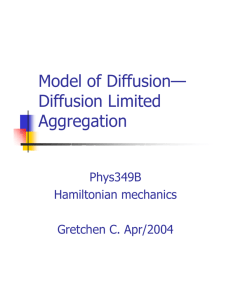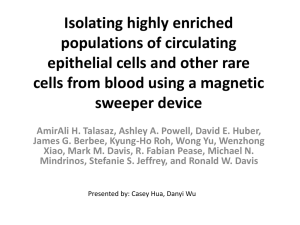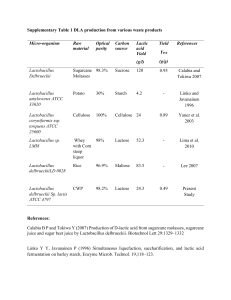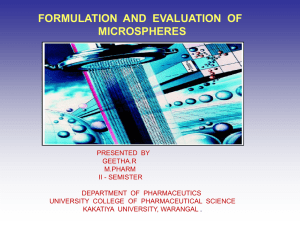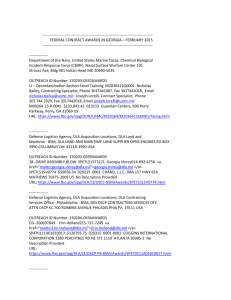experimental and simulated study of diffusion limited
advertisement
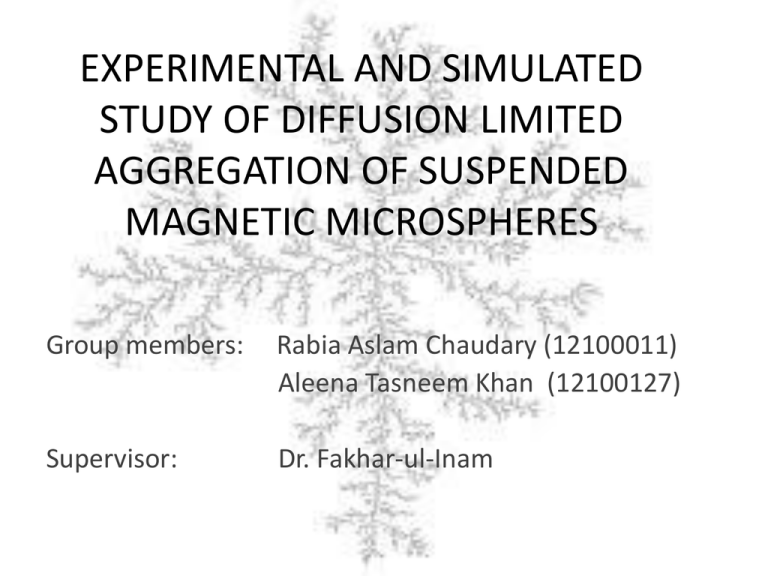
EXPERIMENTAL AND SIMULATED STUDY OF DIFFUSION LIMITED AGGREGATION OF SUSPENDED MAGNETIC MICROSPHERES Group members: Rabia Aslam Chaudary (12100011) Aleena Tasneem Khan (12100127) Supervisor: Dr. Fakhar-ul-Inam OUTLINE • Diffusion Limited Aggregation – – – – What is DLA? The DLA Model and it’s applications Other models Fractal Dimensions • Our approach to the study: – Experimental Study – Simulated study • Past studies done of DLA clusters DIFFUSION LIMITED AGGREGATION What is Diffusion Limited Aggregation? • Diffusion Limited Aggregation (DLA) is an algorithm of simple growth in which a cluster grows when individual particles are added to it through a diffusion-like process. • Originally proposed by Witten and Sander in 1981, the model is used to study wide variety of systems from electrodeposited growth and dielectric breakdown to formation of snow flakes and lightening paths. USING THE DLA MODEL a. Simulated DLA of about 33,000 particles. b. High-voltage dielectric breakdown c. Copper sulfate in an electro-deposition cell • An animation of DLA, for the purpose of our project: Chi-Hang Lam, Applied Physics, Hong Kong Polytechnic University Fractal Dimensions • Fractal dimension is a statistical quantity that indicates how completely the fractal fills space. • The geometrical pattern of fractals is repeated at every small scale • Fractals have non-integer dimension D. log(no. of self similar pieces) • Fractal Dimension = log(magnification factor) D ln r ln( N ) Fractal Dimensions • For clusters in a plane, (in 2D), the fractal dimension D is bounded by the value D = 1.71 • For clusters in space, (in 3D), the fractal dimension D is bounded by the value D = 2.5 • Fractal dimension is sensitive to the lattice structure of the particle and to the environment of the structure. Other models: • The Eden Growth model: Growth of specific type of clusters like bacterial colonies and deposition of metals. Clusters growth by random accumulation of material on their boundary. • The Ballistic Aggregation Model: If the random walks of the particles are placed by ballistic trajectories, we have the ballistic Aggregation model. It generates non-fractal Clusters characterized by a power law. RECENT STUDIES OF THE DLA CLUSTERS • Diffusion-Limited Aggregation, a Kinetic Critical Phenomenon (1981) (T. A. Witten, Jr. and I. M. Sander) Witten and Sander proposed the DLA model studying aggregates formed when a metal vapor produced by heating a plated filament was quench condensed. • Model for the growth of electrodeposited ferromagnetic aggregates under an in-plane magnetic field (2010) (C. Cronemberger, L. C. Sampaio, A. P. Guimarães, and P. Molho) Effect of Increasing magnetic moment and external field on the aggregates and fractal dimensions of ferromagnetic particles. Aggregates by simulations at different values of magnetic moment and applied magnetic field • Aggregation of Magnetic Microspheres: Experiments and Simulations (1988) (G. Helgesen, ' A. T. Skjeltorp, P. M. Mors, ' R. Botet, and R. Jullien) Diffusion Limited cluster aggregation of magnetic microspheres. Complete agreement of experiment and simulation. Aggregates formed as a result of experiment as magnetic field increases from a to d. Simulated Results a. Without dipolar interactions and rotational diffusion b. Without dipolar interactions but with rotational diffusion c. With dipolar interactions and rotational diffusion d. Adding external magnetic field Our model for non-magnetic and magnetic microspheres • We are basing our model on original DLA model for both types of particles. • First particle is placed in the center. Other particles enter from boundary of the cell undergoing a periodic boundary condition and doing Brownian movement and sticks to make aggregate. • At each step, particles have four possibilities for its next position and they are assigned probabilities accordingly. • For magnetic particles, the dipole moment is given by: M( d 3 ) 6 • Magnetic interactions between two spheres, i and j, separated by the distance rij ri r j ,is given by the following relation, u i .u j 3 ( u i .rij )( u j .rij ) D ij 3 2 rij rij • We also have two dimensionless parameters, effective strength of dipole-dipole interactions and dipole-field interactions. 2 K dd K df 2 3 d k BT B ext k BT • The total energy of a particle at the position ri is given by: U mag ( ri ) i . B T ( ri ) • Differently from DLA, the energy difference between the current position and the four possible new positions is used to calculate the probabilities. 1 exp( Pi k BT U i ) P i i • According to this model, the particle moves to the region of lower energy with higher probabilities. EXPERIMENTAL SETUP FOR THE DLA CLUSTER STUDY Experimental Procedure o Study of non-magnetic particles: Particles doing Brownian motion observed by microscope and camera. Possibility of cluster aggregation. o Study of magnetic particles: Sulfonated polystyrene magnetic microspheres with 30% iron oxide dispersed in water confined to a mono-layer. Experimental setup: • Setup to vary temperature • Application of External Field CONTROL PARAMETERS • • • • • Seed Size Doping Solvent External Magnetic field Temperature To study: The effect on Fractal dimensions and scaling properties of the aggregated clusters SIMULATED STUDY OF THE DLA CLUSTER MODEL Outline of simulation FORMATION OF LATTICE AND INTRODUCTION OF SEED LOOP OVER THE DESIRED NUMBER OF PARTICLES UNTIL A CLUSTER IS FORMED CALCULATE FRACTAL DIMENSION BY CALCULATING THE RATIO OF NUMBER OF PARTICLES IN A CERTAIN AREA INTRODUCTION OF PARTICLE AR A RANDOM LOCATION AND RANDOM WALK OF THE PARTICLE (BROWNIAN MOTION) THE PARTICLE ATTACHES TO THE SEED, WITH A PROBABILITY DEPENDENT ON STICKING COEDDECIENT OF THE SYSTEM NEW PARTICLE INTRODUCED AND ABOVE STEPS REPEATED Brownian Motion of a Particle Some results from previous simulations Dendritic Cluster grown in a DLA simulation with 5000 walkers on a 200 X 200 site Spectral Dimensions for the DLA model of Colloid Growth, Paul Meakin, H. Eugene Stanley REFERENCES • Diffusion Limited Aggregation a Kinetic Critical Phenomenon (1981), (T. A. Witten, Jr. and I. M. Sander) • Model for the growth of electrodeposited ferromagnetic aggregates under an in-plane magnetic field (2010) , (C. Cronemberger, L. C. Sampaio, A. P. Guimarães, and P.Molho) • Aggregation of Magnetic Microspheres: Experiments and Simulations (1988) ,(G. Helgesen, ' A. T. Skjeltorp, P. M. Mors, ' R. Botet, and R. Jullien) • Magnetization behavior of small particle aggregates (1998), (K N Trohidou and D Kechrakos) • Spectral Dimension for Diffusion Limited Aggregate model for colliod growth, 1983 (Paul Meakin andK N Trohidou and H. Eugene Stanley) • Scaling Structure of the Surface Layer of Diffusion-Limited Aggregates, 1985 (Thomas C. Halsey, Paul Meakin and Itamar Procaecia) • Pattern Formation in Diffusion-Limited Aggregation, 1984 (Tamas Vicsek) THANKYOU ! QUESTIONS?
